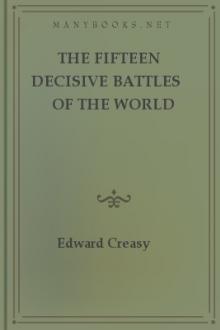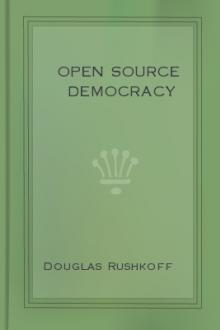The Fifteen Decisive Battles of the World from Marathon to Waterloo by Edward Creasy (reading books for 6 year olds txt) 📕

- Author: Edward Creasy
- Performer: -
Book online «The Fifteen Decisive Battles of the World from Marathon to Waterloo by Edward Creasy (reading books for 6 year olds txt) 📕». Author Edward Creasy
“Near the river Owar, [Probably the Loire.] the two great hosts of the two languages and the two creeds were set in array against each other. The hearts of Abderrahman, his captains, and his men were filled with wrath and pride, and they were the first to begin the fight. The Moslem horseman dashed fierce and frequent forward against the battalions of the Franks, who resisted manfully, and many fell dead on either side, until the going down of the sun. Night parted the two armies: but in the grey of the morning the Moslems returned to the battle. Their cavaliers had soon hewn their way into the centre of the Christian host. But many of the Moslems were fearful for the safety of the spoil which they had stored in their tents, and a false cry arose in their ranks that some of the enemy were plundering the camp; whereupon several squadrons of the Moslem horseman rode off to protect their tents. But it seemed as if they fled; and all the host was troubled. And while Abderrahman strove to check their tumult, and to lead them back to battle, the warriors of the Franks came around him, and he was pierced through with many spears, so that he died. Then all the host fled before the enemy, and many died in the flight. This deadly defeat of the Moslems, and the loss of the great leader and good cavalier Abderrahman, took place in the hundred and fifteenth year.
It would be difficult to expect from an adversary a more explicit confession of having been thoroughly vanquished, than the Arabs here accord to the Europeans. The points on which their narrative differs from those of the Christians,—as to how many days the conflict lasted, whether the assailed city was actually rescued or not, and the like,—are of little moment compared with the admitted great fact that there was a decisive trial of strength between Frank and Saracen, in which the former conquered. The enduring importance of the battle of Tours in the eyes of the Moslems, is attested not only by the expressions of “the deadly battle,” and “the disgraceful overthrow,” which their writers constantly employ when referring to it, but also by the fact that no further serious attempts at conquest beyond the Pyrenees were made by the Saracens. Charles Martel, and his son and grandson, were left at leisure to consolidate and extend their power. The new Christian Roman Empire of the West, which the genius of Charlemagne founded, and throughout which his iron will imposed peace on the old anarchy of creeds and races, did not indeed retain its integrity after its great ruler’s death.
Fresh troubles came over Europe; but Christendom, though disunited, was safe. The progress of civilization, and the development of the nationalities and governments of modern Europe, from that time forth, went forward in not uninterrupted, but, ultimately, certain career.
SYNOPSIS OF EVENTS BETWEEN THE BATTLE OF TOURS, A.D. 732, AND THE
BATTLE OF HASTINGS, 1066.
A.D. 768-814. Reign of Charlemagne. This monarch has justly been termed the principal regenerator of Western Europe, after the destruction of the Roman empire. The early death of his brother, Carloman, left him sole master of the dominions of the Franks, which, by a succession of victorious wars, he enlarged into the new Empire of the West. He conquered the Lombards, and re-established the Pope at Rome, who, in return, acknowledged Charles as suzerain of Italy. and in the year 800, Leo III, in the name of the Roman people, solemnly crowned Charlemagne at Rome, as Emperor of the Roman Empire of the West. In Spain, Charlemagne ruled the country between the Pyrenees and the Ebro; but his most important conquests were effected on the eastern side of his original kingdom, over the Sclavonians of Bohemia, the Avars of Pannonia, and over the previously uncivilized German tribes who had remained in their fatherland. The old Saxons were his most obstinate antagonists, and his wars with them lasted for thirty years. Under him the greater part of Germany was compulsorily civilized, and converted from Paganism to Christianity, His empire extended eastward as far as the Elbe, the Saal, the Bohemian mountains, and a line drawn from thence crossing the Danube above Vienna, and prolonged to the Gulf of Istria. [Hallam’s Middle Ages.]
Throughout this vast assemblage of provinces, Charlemagne established an organized and firm government. But it is not as a mere conqueror that he demands admiration. “In a life restlessly active, we see him reforming the coinage, and establishing the legal divisions of money, gathering about him the learned of every country; founding schools and collecting libraries; interfering, with the air of a king, in religious controversies; attempting, for the sake of commerce, the magnificent enterprise of uniting the Rhine and the Danube, and meditating to mould the discordant code of Roman and barbarian laws into an uniform system.” [Hallam, UT SUPRA.]
814-888. Repeated partitions of the empire and civil wars between Charlemagne’s descendants. Ultimately, the kingdom of France is finally separated from Germany and Italy. In 982, Otho the Great, of Germany, revives the imperial dignity.
827. Egbert, king of Wessex, acquires the supremacy over the Anglo-Saxon kingdoms.
832. The first Danish squadron attacks part of the English coast. The Danes, or Northmen, had begun their ravages in France a few years earlier. For two centuries Scandinavia sends out fleet after fleet of sea-rovers, who desolate all the western kingdoms of Europe, and in many cases effect permanent conquests.
871-900. Reign of Alfred in England. After a long and varied struggle, he rescues England from the Danish invaders.
911, The French king cedes Neustria to Hrolf the Northman. Hrolf (or Duke Rollo, as he thenceforth was termed) and his army of Scandinavian warriors, become the ruling class of the population of the province, which is called after them Normandy.
1016. Four knights from Normandy, who had been on a pilgrimage to the Holy Land, while returning through Italy, head the people of Salerno in repelling an attack of a band of Saracen corsairs.
In the next year many adventurers from Normandy settle in Italy, where they conquer Apulia (1040), and afterwards (1060) Sicily.
1017. Canute, king of Denmark, becomes king of England. On the death of the last of his sons, in 1041, the Saxon line is restored, and Edward the Confessor (who had been bred in the court of the Duke of Normandy), is called by the English to the throne of this island, as the representative of the House of Cerdic.
1035. Duke Robert of Normandy dies on his return from a pilgrimage to the Holy Land, and his son William (afterwards the conqueror of England) succeeds to the dukedom of Normandy.
CHAPTER VIII.
THE BATTLE OF HASTINGS, 1066.
“Eis vos la Bataille assemblee,
Dunc encore est grant renomee.” ROMAN DE ROU, 1. 3183.Arletta’s pretty feet twinkling in the brook gained her a duke’s love, and gave us William the Conqueror. Had she not thus fascinated Duke Robert, the Liberal, of Normandy, Harold would not have fallen at Hastings, no Anglo-Norman dynasty could have arisen, no British empire. The reflection is Sir Francis Palgrave’s: [History of Normandy and England, vol. i. p. 528.]
and it is emphatically true. If any one should write a history of “Decisive loves that; have materially influenced the drama of the world in all its subsequent scenes,” the daughter of the tanner of Falaise would deserve a conspicuous place in his pages.
But it is her son, the victor of Hastings, who is now the object of our attention; and no one, who appreciates the influence of England and her empire upon the destinies of the world, will ever rank that victory as one of secondary importance.
It is true that in the last century some writers of eminence on our history and laws mentioned the Norman Conquest in terms, from which it might be supposed that the battle of Hastings led to little more than the substitution of one royal family for another on the throne of this country, and to the garbling and changing of some of our laws through the “cunning of the Norman lawyers.”
But, at least since the appearance of the work of Augustin Thierry on the Norman Conquest, these forensic fallacies have been exploded. Thierry made his readers keenly appreciate the magnitude of that political and social catastrophe. He depicted in vivid colours the atrocious cruelties of the conquerors, and the sweeping and enduring innovations that they wrought, involving the overthrow of the ancient constitution, as well as of the last of the Saxon kings. In his pages we see new tribunals and tenures superseding the old ones, new divisions of race and class introduced, whole districts devastated to gratify the vengeance or the caprice of the new tyrant, the greater part of the lands of the English confiscated and divided among aliens, the very name of Englishmen turned into a reproach, the English language rejected as servile and barbarous, and all the high places in Church and State for upwards of a century filled exclusively by men of foreign race.
No less true than eloquent is Thierry’s summing up of the social effects of the Norman Conquest on the generation that witnessed it, and on many of their successors. He tells his reader that “if he would form a just idea of England conquered by William of Normandy, he must figure to himself, not a mere change of political rule, not the triumph of one candidate over another candidate, of the man of one party over the man of another party; but the intrusion of one people into the bosom of another people, the violent placing of one society over another society, which it came to destroy, and the scattered fragments of which it retained only as personal property, or (to use the words of an old act) as ‘the clothing of the soil:’ he must not picture to himself on the one hand, William, a king and a despot—on the other, subjects of William’s, high and low, rich and poor, all inhabiting England, and consequently all English; but he must imagine two nations, of one of which William is a member and the chief—two nations which (if the term must be used) were both subject to William, but as applied to which the word has quite different senses, meaning in the one case subordinate, in the other subjugated. He must consider that there are two countries, two soils, included in the same geographical circumference; that of the Normans rich and free, that of the Saxons poor and serving, vexed by RENT and TAILLAGE; the former full of spacious mansions, and walled and moated castles, the latter scattered over with huts and straw, and ruined hovels; that peopled with the happy and the idle, with men of the army and of the court, with knights and nobles,—this with men of pain and labour, with farmers and artizans: on the one side, luxury and insolence, on the other, misery and envy—not the envy of the poor at the sight of opulence they cannot reach, but the envy of the despoiled when in presence of the despoilers.”
Perhaps the effect of Thierry’s work has been to cast into the shade the ultimate good effects on England of the Norman Conquest. Yet these are as undeniable as are the miseries





Comments (0)